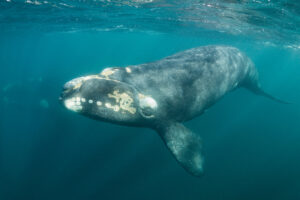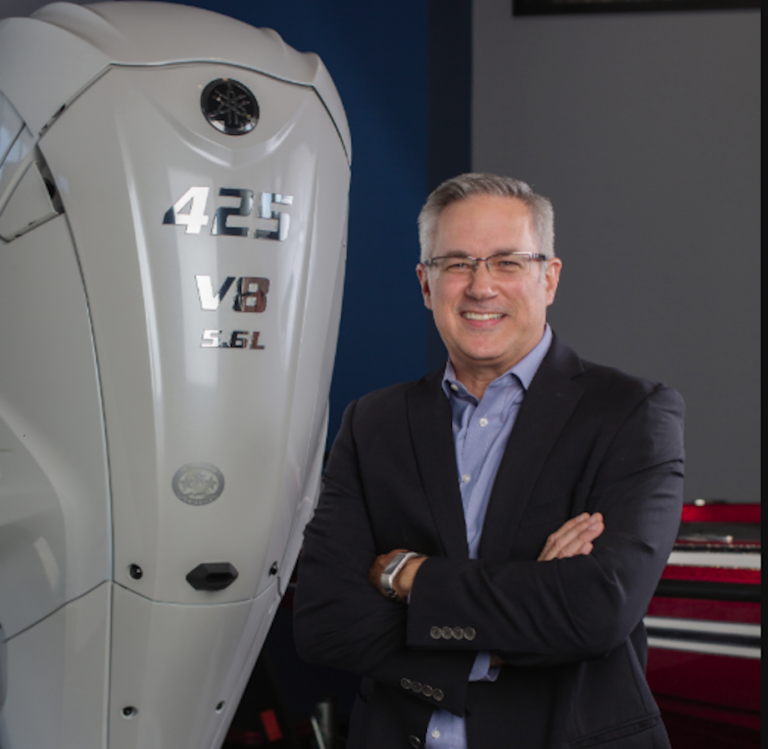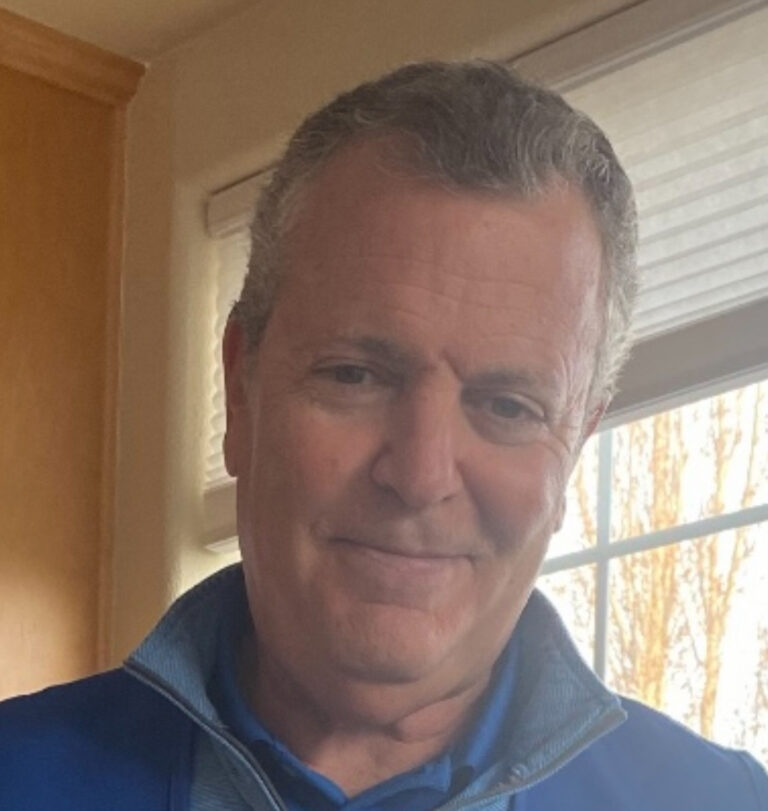
After several years of high-horsepower introductions, outboard engine manufacturers have shifted their focus to the mid-range, with Yamaha debuting a much lighter 90-hp 4-stroke and Evinrude pushing out several models from 150 to 200 hp with its G2 technology.
Meanwhile, the popularity of wake surfing and other tow sports has prompted the arrival of new wave-shaping propulsion systems created through boat and engine manufacturer partnerships. Mercury announced that its Joystick Piloting technology can now be used in applications with inboard power. Sea Ray uses the Mercury Joystick on its new 230-W SLX, an inboard-powered boat built with a new system consisting of trim tabs, fins and ballast tanks that controls the wake. Chaparral also has a wake-surfing line of boats, but it uses Volvo Penta’s Forward Drive and Malibu’s wake-surf system.
Volvo Penta at this year’s Miami International Boat Show planned to introduce the last of its next-generation gasoline sterndrives (380- and 430-hp models). The Swedish engine maker in mid-2016 also introduced a joystick system specifically for inboard-powered boats, along with another diesel engine and accompanying pod unit for its Inboard Performance System (IPS). Here’s a closer look at what the major engine manufacturers have been up to.
Yamaha
Yamaha introduced two new outboards at last month’s Minneapolis Boat Show — the F90/F75 and the F25. “We want to launch new products when they’re ready — and these two engines were ready to go,” says Martin Peters, Yamaha Marine Group communications manager.
The new F90/F75 is a more powerful but lighter engine than its predecessor, which was introduced in 2005. The new 353-pound F90 has a displacement of 1.8 liters and is 13 pounds lighter than the previous 366-pound model. “It’s a real gutsy engine, with a single overhead cam driving four valves per cylinder,” says David Meeler, Yamaha information manager. “It shares the same block as our F115 but is a completely new engine.”
The engine should be ideal for all types of boats, including saltwater center consoles, pontoons, large aluminum freshwater fishboats and runabouts, says Meeler. “We’re really excited about this engine and how powerful it is for its size and weight,” he says. “When you punch the throttle you’ll be hard-pressed to believe it’s a 90-hp. The previous F90 was a great engine, but getting a little long in the tooth, so it was time for something new — and better.”
The F90 has Yamaha’s variable trolling technology and an improved alternator output, with 35 amps of power. It’s also compatible with Yamaha’s Talon propellers.
The new F25 replaces the F25 that had been offered since 2009. “The boaters in the Midwest have been asking for a new 25 for a long time now,” says Peters. “Minneapolis was a fitting venue for the launch.”
The new F25 is 25 percent lighter than the previous model, with a weight range of 126 to 143 pounds (depending on shaft length and model), compared with 168 to 181 pounds for its predecessor. The F25 is a battery-less electronic fuel-injected engine, meaning its fuel injection system and its ignition system kick in during pull starting, says Meeler.
“Both systems don’t engage until the second pull on most other EFI engines of this size,” says Meeler. “We wanted the new F25 to fire off on the first pull. It actually starts at about one-half of a pull. That explains why it has taken [Yamaha] a little longer to come to market with this engine.”
Yamaha in 2016 also upgraded its largest 4-stroke, the 350-hp V-8, which was first introduced 10 years ago.
Yamaha has made so many improvements to the 5.3-liter engine since its introduction in 2007 that it was time to present them as a package in a new next-generation engine, says Meeler. The improvements have made the engine more durable and easier to maintain. “We have a new engine with a freshened-up look and we’re covering it with a 5-year warranty,” says Meeler.
The upgrades include the addition of Yamaha’s Shift Dampener System, which reduces “clunking” noises and vibration during shifting and low-speed operation. The F350 has gotten lighter over its life, slimming from 804 to 763 pounds. An improved electronic control unit alerts owners when the engine is due for service in selective maintenance areas.
Yamaha also has improved corrosion resistance in areas near the waterline. The company in 2016 continued to promote its freshwater lineup of high-horsepower 4-strokes — the MAX SHO (Super High Output) series. Yamaha also introduced a new Talon propeller designed for its 4-strokes from 70 to 115 hp, as well as its 50- and 60-hp high-thrust 4-strokes and any older 2-strokes from 60 to 130 hp.
The engine-maker also began promoting the sale of its mechanically controlled 225- and 250-hp 4.2-liter V6 Offshore outboards, which serve the repowering market.

Evinrude
It was a big year for Evinrude, which introduced several mid-range 2-stroke outboards with the E-TEC next-generation 2-stroke technology. The company launched four models — the G2 150, 150 H.O. (high output), 175 and 200. The four join the higher-horsepower G2 models (up to 300 hp) that came out in 2014.
“With 200-plus-hp engines your reach is smaller and caters to the offshore saltwater market, the bass fishing and professional fishing markets, and the larger pontoons,” says Alain Villemure, vice president and general manager of BRP’s marine propulsion systems division. “With the 150, we are serving a segment that all boat manufacturers exploit and is very important. So we will further spread the word about our innovative G2 technology.”
Evinrude will continue upgrading its engines with the G2 technology. The transition of the lower-hp outboard from 25 to 135 should be complete by 2018-2019.
Torque, fuel economy and low emissions are the three major performance strengths of the engines, says Villemure. “You’re pushing a boat through water, so there is no other product line where torque is so critical,” he says.
Although Evinrude continues to gain dealers, executives say they need to strengthen the brand identity by fully defining its mission, vision and purpose in the marketplace. And the Canadian company has brought in a new marketing executive to meet those goals. Olivier Pierini took on the role of director of global marketing and strategic planning in late 2016. Pierini says he wants to “re-germinate the Evinrude brand and bring a bit of swagger to the brand.”
Pierini also wants Evinrude to simplify its marketing efforts so more consumers understand the value of the brand. “It’s good to have the technical information, but we want to make sure the consumer understands the benefits,” says Pierini, who has extensive experience in the auto industry, having worked for Nissan, Ford, Volvo and BMW. “We want people to know that they have a premium product.”

Mercury
The 115 ProXS engine Mercury brought to market in 2016 “has been an overwhelming success,” says David Foulkes, Brunswick Corp.’s vice president and chief technology officer and vice president of product development, engineering and racing for Mercury. The engine maker also extended its lineup of SeaPro commercial outboards, adding 40- and 60-hp models to the existing 75- to 150-hp SeaPro models. “They’re designed with durability and features to meet the needs of the most demanding commercial environments,” says Foulkes.
Mercury continues to push its 350 Verado and Mercury Racing 400R outboards (introduced in Miami in 2015). Foulkes says more than half of the combined total of triple-engine and quad-engine boats were equipped with these Mercury outboards at the 2016 Fort Lauderdale International Boat Show.
Last year was a particularly big year for Mercury’s controls and rigging product lines, Foulkes adds. The company introduced a new version of its Joystick Piloting system with more features and enhanced control authority and an IBEX award-winning “magneto rheological” steering system. In addition, Mercury launched new versions of its VesselView multifunction displays and VesselView Link, which allows the VesselView user interface to be displayed on glass-dash displays and Lowrance fishfinders.
The VesselView mobile app and its companion Bluetooth module allow the app to connect to SmartCraft to access all propulsion system data. The app displays engine and propulsion system data, shows fuel consumption, enables planning of maintenance and service, assists with fault diagnosis, displays Mercury dealer locations and interfaces with social media.
In addition, Sea Ray and Mercury in late 2016 announced the extension of the Mercury Joystick Piloting platform to tow-sport boats, beginning with Sea Ray’s new SLX-W 230 wake sports boat. It uses many of the same components as the other systems, but coordinates the operation of the main engine and two thrusters to maneuver the boat, says Foulkes. The system is designed to operate with the 320-hp and 370-hp inboard/V-drive tow sports derivatives of Mercury’s new purpose-built gasoline 4.5L V6 and 6.2L V8 engines. These engines also are equipped with advanced launch-control and speed-control capabilities that are suited for wake surfing, water skiing and wakeboarding.
The Sea Ray SLX-W 230 uses outboard triangular trim tabs, a pair of vertical centerline fins and three ballast tanks to create the desired size and shape of the wake for surfing or wakeboarding.
“With the touch of a button, the driver can switch the surfing wake from one side of the boat to the other,” says Kevin Reilly, director of product portfolio and customer service for Sea Ray sport boats and sport cruisers. “All of the technologies work together to give you a really robust wake that’s completely controllable.”
Without a sterndrive appendage, the safety factor is increased with the SLX-W 230, says Reilly.

Volvo Penta
This year’s Miami International Boat Show will mark a milestone for the Swedish engine maker as it brings to market the final two products in its fleet of next-generation gasoline sterndrives. The V8-430 and V8-380 use General Motors Generation V engines. I got a chance to drive a Volvo Penta test boat — a Chris-Craft Corsair 32 — powered with a pair of the new V8-430s at last October’s IBEX. The new V8-430 and 380 incorporate the same engineering technologies as the other next-gen gas sterndrive engines that Volvo Penta has introduced during the past two years. Ron Huibers, president of Volvo Penta of the Americas, says they’re lighter, with all-aluminum construction, and faster and more efficient with direct fuel injection and variable valve timing. “But you have to feel it to believe it,” Huibers said as he welcomed me to take the Corsair’s helm.
The speed was certainly there — 56 mph — and the engines responded quickly from 3,000 to 5,000 rpm. The head-jerking mid-range torque makes it feel as if you’re driving a much smaller boat. After ripping around Tampa Bay for 20 minutes, I turned my attention to fuel economy. At a comfortable cruise of about 33 mph the helm gauges told us we could travel 1.8 miles to the gallon — pretty good for a 32-footer at this speed.
The V8-380 is 25 percent faster and 11 percent more fuel-efficient at 25 mph than its predecessor, says Huibers. The V8-430 is 15 percent faster and 10 percent more fuel-efficient. Both are 110 pounds lighter than their predecessors, he says.
The company in 2014 introduced the first of its next-generation engines — the 4.3-liter V6 in 200- and 240-hp models. The V6-280, V8-300 and V8-350 followed in 2015. Volvo Penta also captured an Innovation Award at IBEX for its engine-draining system (Easy Drain), a gasoline sterndrive raw water engine-draining system that can be activated with a single knob whether the boat is in or out of the water.
Volvo Penta last year introduced a joystick helm control system — Joystick Inboard — for conventional twin inboard-powered boats, along with another model of its Inboard Performance System. The new IPS links a new pod (IPS 15) and a new diesel, the D8 (offered in 600- and 550-hp models). The D8, put into production on Volvo trucks and buses in 2013, is an 8-liter, inline six-cylinder diesel. The IPS700 uses the 550-hp D8, and the IPS800 works with the 600-hp D8.
The IPS700/800 bridges the gap between the IPS600 (435 hp) and IPS950 (725 hp).
The IPS700/800 can be used in twin and triple installations on boats from 45 to 55 feet. The IPS range spans 350- to 900-hp versions. IPS was introduced in 2005, and its accompanying joystick came to the market in 2006.
Joystick Inboard can be used with all electronically controlled Volvo Penta diesels from the D3 (150 hp) to the D13 (900 hp) in twin applications. Joystick Inboard uses the engine’s propellers, electrical steerage of the rudders and a bow thruster to maneuver the boat. “We take over from helm to prop,” says Huibers.
Volvo Penta’s wake surfing propulsion system — Forward Drive — is now being used on a special line of Chaparral boats. Chaparral is offering the Malibu wake-surf system on five models from 22 to 26 feet. The company is using Volvo Penta’s Forward Drive and has licensed Malibu’s Surf Gate wake-shaping technology.
These five models make up Chaparral’s Surf Series: the 227 SSX, the 257 SSX, the 244 Sunesta, the 264 Sunesta and the 246 SSi.
Since it was introduced in 2013, Malibu’s wake-shaping technology has almost a 100 percent adoption rate, with well over 3,000 systems sold per year, says Malibu Boats spokesman Thomas Tedford. One of the selling points of the system is a remote wristband, which allows surfers to switch the wake from side to side.

Suzuki/Honda/Cummins
Suzuki Marine late last year introduced two new models in its AP Series of inline four-cylinder 4-stroke engines. The DF150AP and DF175AP are built with the 175-cubic-inch displacement engine that is used for its second-generation 200-hp 4-stroke (which hit the market in 2015). “There’s no replacement for displacement,” says Dean Corbisier, Suzuki director of press relations and event management. “The two engines have the largest displacement in their respective horsepower classes, packing a heck of a punch.”
Like the DF200AP, the new 150 and 175 operate with digital throttle and shift controls and include Suzuki’s Lean Burn fuel management technology, which delivers excellent fuel economy in the mid-range, says Corbisier. They also come with the company’s selective rotation capability for either standard or counter rotation operation. This eliminates the need to stock separate standard and counter rotation models and provides the consumer with an outboard that can easily be changed when it’s time to upgrade, says Corbisier.
More good news: Suzuki offers the DF150AP in a 20-inch shaft, so smaller twin-outboard boats can benefit from the upgraded technology and counter rotation, says Corbisier. The fly-by-wire digital throttle and shift makes the installation of a second helm station much easier, he adds. Suzuki will still offer the less-expensive DF150 and DF175 models with mechanical controls. Suzuki plans to introduce another high-horsepower engine at the Miami International Boat Show, but no details were immediately available.
Honda focused on small engines in 2016, debuting three 60-pound 4-strokes. The new BF4/5/6 are available with either a short (15-inch) or long (20-inch) shaft.
The engines are built with a new internal fuel tank and new motor mounts to run quietly and smoothly while delivering the longest continuous running time, the company says.
Honda has virtually eliminated tiller handle vibration with these three engines, says OEM sales manager Dennis Ashley. The engine powerhead is separated from the tiller handle, so although the engine might be vibrating, the user does not feel it, says Ashley. “These 1-cylinder engines vibrate — everyone’s single-cylinder engine does,” Ashley says. “It’s tough to stop the vibration with all the opposing weights. We’ve isolated the tiller handle.”
Cummins continues to promote its streamlined version of its QSB6.7 diesel — the QSB6.7 SL (Slim Line), a less expensive, lighter alternative without certain features. In addition, Cummins in 2016 extended the C Command product line with the release of C Command Connect — a panel system designed for its Quantum Series QSB6.7, QSC8.3, QSL9 and QSM11 marine engines. The C Command system is a modular selection of instrumentation and control panels engineered to help marine operators protect and enhance engine operation, as well as manage operating costs. Each element is designed for complete integration with the engine and for simplified vessel installation, with “plug and play” capability.
This article originally appeared in the February 2017 issue.











